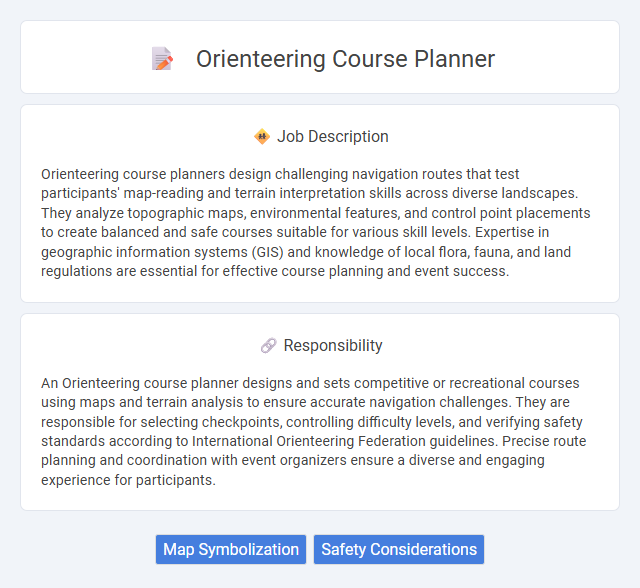
Orienteering course planners design challenging navigation routes that test participants' map-reading and terrain interpretation skills across diverse landscapes. They analyze topographic maps, environmental features, and control point placements to create balanced and safe courses suitable for various skill levels. Expertise in geographic information systems (GIS) and knowledge of local flora, fauna, and land regulations are essential for effective course planning and event success.
Individuals who enjoy outdoor activities, have strong spatial awareness, and possess problem-solving skills are likely suitable for an orienteering course planner role. Those who prefer structured environments or have limited physical stamina may find the demands of designing and testing courses challenging. Familiarity with navigation tools and a passion for adventure could increase the probability of success in this job.
Qualification
A successful Orienteering Course Planner must possess in-depth knowledge of map reading, terrain analysis, and navigation techniques. Expertise in geographic information systems (GIS) and software tools like OCAD enhances course design precision and safety. Strong problem-solving skills and experience with environmental regulations ensure courses meet competitive and ecological standards.
Responsibility
An Orienteering course planner designs and sets competitive or recreational courses using maps and terrain analysis to ensure accurate navigation challenges. They are responsible for selecting checkpoints, controlling difficulty levels, and verifying safety standards according to International Orienteering Federation guidelines. Precise route planning and coordination with event organizers ensure a diverse and engaging experience for participants.
Benefit
Working as an orienteering course planner likely offers valuable opportunities to enhance navigational skills and deepen understanding of terrain analysis. There is a strong chance to collaborate with outdoor enthusiasts and contribute to creating engaging, challenging routes for participants. The role may also provide personal satisfaction and improved problem-solving abilities through designing safe and fair courses.
Challenge
An orienteering course planner likely faces the challenge of designing routes that balance difficulty and navigation skill, ensuring courses are engaging yet achievable for participants. The planner may encounter obstacles such as diverse terrain considerations and the need to maintain safety while testing orienteers' map-reading abilities. Success probably depends on creativity, attention to detail, and a deep understanding of the sport's requirements.
Career Advancement
Expertise in Orienteering course planning enhances strategic skills in map analysis, terrain evaluation, and navigation system design, positioning professionals for senior roles in outdoor event management and sports education. Mastery of Geographic Information Systems (GIS) and advanced route optimization techniques allows seamless progression into leadership positions, including project management and national-level competition coordination. Continuous skill development in safety protocols and competitor engagement drives career growth opportunities within international orienteering federations and adventure sports organizations.
Key Terms
Map Symbolization
An orienteering course planner specializing in map symbolization ensures accurate and clear representation of terrain features using standardized symbols and color codes to facilitate navigation. Expertise in topographic map interpretation and GIS software enables the creation of legible and reliable course maps that enhance participant experience and safety. Precise symbolization supports effective route choice decisions, minimizing navigation errors during orienteering events.
Safety Considerations
Orienteering course planners must prioritize safety by thoroughly assessing terrain hazards, such as uneven ground, water bodies, and dense vegetation, to minimize risks for participants. Implementing clear signage, emergency access points, and communication protocols ensures rapid response during incidents. Regularly updating risk assessments in line with weather conditions and participant skill levels enhances overall course safety.
 kuljobs.com
kuljobs.com